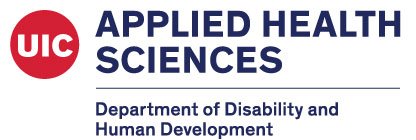By Ashleigh Nightengale, L.S.W.
Illinois LEND Program Cohort 2024 – 2025
As a person with cerebral palsy who uses disability services, I see a lack of continuity between the services provided at one stage of life and the next, specifically in the educational and healthcare field. In education, the I.E.P. "Individualized Education Plan," directs educational support through high school with input from teachers, parents, and students; however, there is no equivalent mandate disability support in college education settings. This makes obtaining a degree (which opens doors for employment and financial mobility) even more challenging. In healthcare, the medical model of disability, a heavily biased viewpoint of people with disabilities as something to be fixed, plays a big part in the goal setting process with therapists. For example, The therapist may come in with a preconceived notion of the individual's capabilities and range of improvement.
How do ensure that people with disabilities are working towards the goals that are meaningful to them? How do we improve continuity between supports across sectors? How do we facilitate individuals becoming successful, self-sufficient adults with disabilities?
My answer to this question is utilizing the CareMap, a diagram of people and services the individual with a disability uses to manage their care, as their care is complex and requires different services. The key here is to ensure that these different services are in constant communication to facilitate the completion of the individual and care team/family's expressed goals. The CareMap keeps the person with a disability in the driver's seat, allowing them to exercise autonomy and independence regardless of their impairment.
By introducing the CareMap as early as possible, for example in early childhood, we set the foundation for working with all aspects of the individual's needs. The family should try to understand what they want their child to achieve at this early stage. As the individual grows, they can communicate the goals that they want to achieve with the support of their family/care team. The CareMap may change, so new service connections may be added as needed. Utilizing the CareMap, we can more easily establish achievable goals that can be built upon to improve the individuals' knowledge and skills to progress even further than what is expected of them because of their disability. The CareMap should address all aspects of life for a person with a disability. The Care Map "allows a person to visualize and easily understand the connections between the people caring for someone. Having individuals look at their goals in this way allows them to utilize different aspects of their support system to the best of their ability to accomplish their goals.
In my life, systematic barriers and provider bias have played significant roles in decision-making in both education and healthcare without my input. If it had not been for my family's support, I would have fallen through the cracks. I was not informed about the importance of the care team or care mapping; all I had was my family and word-of-mouth from other people with disabilities that I knew. My healthcare and educational journey was filled with trial and error. Despite this, I am a licensed social worker for the state of Illinois and a recipient of 2 master's degrees, one in social work and the other in grant writing. In addition to this, I can do everyday things with support. When I was first diagnosed with cerebral palsy at a year old, my mother thought I would not be able to write my name, let alone gain a professional license and go to the doctor on my own. I accomplished so much because of my determination and my family's support.
Nevertheless, being introduced and utilizing the CareMap throughout my journey would have helped me avoid some of my challenges. Using the CareMap, I could have utilized the resources to request better academic support in college, which would have helped me be more successful and finish on time. In addition to this, it would have allowed me the knowledge to investigate schools and find an even better school for my 2nd Master's degree that could support my needs. Moreover, using the CareMap would have given me more forethought to ask more questions of my therapist (as I would have insight from other providers) to inquire about new techniques to make me physically stronger and more independent.
The CareMap is the tip of the iceberg when fighting for services to ensure top-quality disability services that can enhance the individual's quality of life. It is up to the individual and care team/family to constantly seek new information, partners, and allies to increase their knowledge of different care and services that could help them in specific areas of their lives. It is up to clinicians, care team/family members, and advocates like me to address the healthcare issues concerning people with disabilities from a biopsychosocial approach and, at the same time, fight for equity and inclusion within society.
References
Pallium Canada Compassionate Communities. (2021). How to Create a CareMap. https://www.pallium.ca/wp-content/uploads/2021/06/Care-Map-Toolkit_How-to-Create-a-Care-Map.pdf
University of California, San Francisco. (2018). Medical and Social Models of Disability. Office of Developmental Primary Care. Retrieved September 6, 2024, from https://odpc.ucsf.edu/clinical/patient-centered-care/medical-and-social-models-of-disability#:~:text=The%20Medical%20Model%20views%20disability%20as%20a%20defect
U.S. Department Of Education. (2020). I.E.P. guide to IDEA 97. https://www2.ed.gov/parents/needs/speced/iepguide/iepguide.pdf











